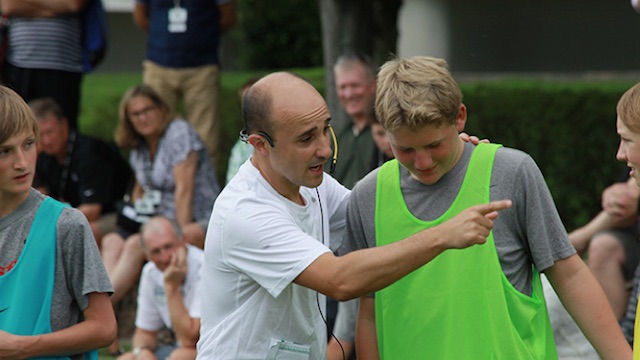US Club Soccer, La Liga partner for coaches

Last year, US Club Soccer’s announcement that it had struck a technical partnership with La Liga sent whitecaps through the American youth development pool. As part of its newly announced Players First model, US Club Soccer was about to offer up technical instruction from La Liga’s finest filtered through an American lens.
Now that some of US Club Soccer’s top officials have seen up close exactly what they’re about to unleash on the U.S., they’re more fired up about the partnership than ever.
A few weeks ago, four US Club Soccer higher-ups took a three-pronged trip to Spain to engage in what they called a “training the trainer” course. This year, US Club Soccer intends to offer a series of coaching courses headed up by La Liga officials, and four of US Club Soccer’s own took a crash course in what it was about to offer interested coaches across the U.S.
Alongside colleagues Ben Ziemer, Ian Mork and Jay Howell, US Club Soccer Executive VP Christian Lavers trekked to Madrid, Bilbao and Barcelona to discuss theory, take in training sessions and bat around ways to implement their new course once it becomes a reality Stateside later this year. For all parties involved, the trip was quite the experience.
The four flew into Madrid, where they met with La Liga methodology consultant and course leader Gari Fullaondo to take in training at the Real Madrid academy. From there, the group trekked to Bilbao, where they watched Athletic Bilbao’s first team train before visiting local third division side Arenas. The last leg of the trip took them to Barcelona, where over two days they watched Barca’s U8 team play in addition to the U12s and U14s.
Intertwined amidst all of this was plenty of discussion as to how this all would relate to an American coaching audience. How to take what the Spanish were teaching their young players and make it applicable in the fields of Los Angeles or Dallas or Philadelphia?
The trip to Spain was not, in sum, an effort to synthesize some nebulous Spanish style and then port it to American clubs. What the American delegation found was that the Spanish methodology is in place to empower coaches to impart their own manner of play. The important part was simply coming up with a way to codify that into a teachable package.
“Their perspective isn’t that they had a style of play they must teach, or it’s their role how to tell you how to coach your teams in terms of style, recognizing that every city has a different culture, coaches have different perspectives,” Lavers said. “What their job is as educators is that you have a methodology to teach your style, and to teach players how to play the game. Because the philosophy basically is that great players can play in any style.
“It’s a refreshing philosophy.”
The quartet returned to the U.S. with plenty of ideas. US Club Soccer will offer a supplemental coaching course outside the purview of the typical licensing system for the first time this year. The courses will follow three escalating tiers, from three to one, and each will offer a ramped up level of instruction. The first course is 22 hours guided by some of the principles gathered from the La Liga partnership. Lavers said it’s viewed more as continuing education program than a license course.
The crew realized just how sophisticated the arena was that they’d stepped into when they saw the clubs using a resource called Kismet. The periodization tool allows administrators to input things like competition days and training days, and spits out a schedule for entire season down to type of activity and training intervals, all of which is modifiable.
As for next steps, US Club Soccer will host a field session, a panel discussion and a classroom session at the NSCAA Convention in Baltimore next week alongside some of its La Liga partners to essentially debut much of these tenets to an American audience. From there, they’ll travel around the country to begin these coaching education sessions in various places.
For US Club Soccer, the initiative goes beyond anything they’ve done before and hopefully opens up a new, higher avenue of coaching education for a broad range of coaches.
“If we actually apply professional coaching - and I don’t mean some guy in an expensive track suit, but somebody who’s professional in their approach to teaching youth - that’s the answer to development in this country,” Lavers said. “It’s not pouring huge amounts of resources into 16-year-olds. It’s to teach the kids we have at those formative age groups so much better.”
Trending Videos
Headlines
- SIMA Recruiting Roundup: April 15-21
- How Do I Get Scouted by TopDrawerSoccer?
-
Girls Academy Showcase Standouts

-
2024 Big Sky Women's Breakout Candidates

- TopDrawerSoccer TeamRank Update - Boys
-
2024 Big Ten Women's Breakout Candidates

-
2027 Boys IMG Academy Rankings Spotlight

- TDS Girls Regional Rankings: Class of 2027
-
ECNL Boys Texas Under-16 Standouts

-
2024 Big Ten Men's Breakout Candidates

